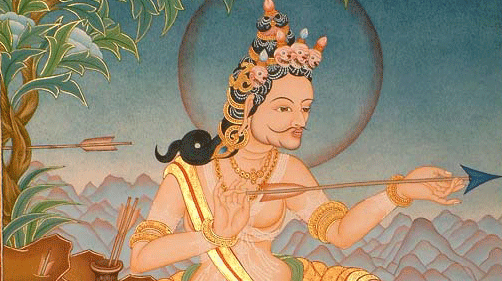The Kagyu lineage originated with the great yogi Tilopa who lived in Northern India around the 10th century A.D. Tilopa received the four special transmissions (Tib.: bka-babs-bzhi) and mastered them.

Although there is some discrepancy in historical accounts regarding the identities of the masters associated with each of the four transmissions the most common consensus indicates that their sources are as follows: the first of the four came from Nagarjuna and consists of two tantras, the “Sangwa Düpa Tantra” (Skr.: Guhyasamaya) and the “Denshi Tantra.”
It also incorporates the practices called “Illusory Body” (Tib.: sgyu-lus) and “Transference” (Tib.: pho-ba). The second special transmission came from Nakpopa and includes the tantra called “Gyuma Chenmo” (Skr.: Mahamaya) and the practice called “Conscious Dreaming” (Tib.: rmi-lam). The third special transmission came from Lawapa. It includes the “Demchok Tantra” and the practice of “Clear Light” (Tib.: od-gsal). The fourth was transmitted from Khandro Kalpa Zangmo and includes the trantra known as “Gyepa Dorje” (Skr.: Hevajra), and the practice called “Tummo.”
These teachings were passed on from Tilopa to Naropa, and were systematized as the Six Yogas of Naropa, considered a central theme in the Kagyu Lineage. Naropa transmitted his knowledge to Marpa, the great translator who journeyed from Tibet to India in order to receive instructions and who subsequently returned to Tibet and spread the teachings of the Dharma.
His student, Milarepa, became one of Tibet’s great yogis. Through perseverance in the practice of Mahamudra and the Six Yogis of Naropa, he achieved profound realization of the ultimate nature of reality.
Milarepa’s transmission was carried on by Gampopa, the physician from Dagpo. He studied the Kadampa tradition, which is a gradual path that includes what are called the Lam Rim teachings. He also met Milarepa, and attained realization of ultimate reality under his guidance. He established monastic institutions, taught extensively and attracted many students. Four of his disciples founded the four major Kagyu schools: Babrom Dharma Wangchuk founded the Babrom Kagyu, Pagdru Dorje Gyalpo founded the Pagdru Kagyu, Shang Tsalpa Tsondru Drag founded the Tsalpa Kagyu, and Karmapa Düsum Khyenpa founded the Kamtsang Kagyu, also known as the Karma Kagyu School.
It was the first Karmapa, Dusum Khyenpa, who received the complete Mahamudra transmission from Gampopa.
The eight minor Kagyu lineages originated disciples. These eight lineages are the Taglung Kagyu, Trophu Kagyu, Drukpa Kagyu, Martsang Kagyu, Yerpa Kagyu, Yazang Kagyu, Shugseb Kagyu and Drikung Kagyu. The different Kagyu lineages are not referred to as major and minor in terms of the instructions they contain, they are equal in that respect.
The four major lineages are so-called in that they originate with Gampopa himself, whereas the eight minor lineages originate with a later generation of masters. Nowadays, among the four major Kagyu lineages only the Karma Kagyu remains prevalent. Among the eight minor Kagyu lineage’s only the Taglung, Drukpa and Drikung Kagyu still exist lineages independently.
One can distinguish several transmissions within each lineage. However, all major Buddhist traditions in Tibet have a lineage of the Pratimoksha-Vows and a lineage of the Bodhisattva-Vows.
“The Golden Kagyu Garland” refers to the masters who are holders of the lineage in which Mahamudra is a main theme. They are the Indian masters of the lineage and the successive reincarnations of the Karmapas and their most important students who pass on the transmissions. The lineage holders are selected by the Karmapa himself which ensures that the teachings remain intact and pure.
“The Golden Kagyu Garland” refers to the masters who are holders of the lineage in which Mahamudra is a main theme. They are the Indian masters of the lineage and the successive reincarnations of the Karmapas and their most important students who pass on the transmissions. The lineage holders are selected by the Karmapa himself which ensures that the teachings remain intact and pure.
Similarly, it is the Karmapa himself who always chooses the teacher whose task it will be to pass on the lineage to him in his future incarnation. He is a great bodhisattva who has the capacity to perceive the realisation and qualities of others. It is through this ability that he selects his own guru. There is no fixed rule which defines the teacher in advance. In some cases the lineage holders are eminent reincarnates and in other cases exceptional practitioners without high status in the religious hierarchy.
Another aspect of the Karma Kagyu lineage is the interim directors of the administration who are caretakers of the Karmapa’s monasteries in between his reincarnations. These caretakers are not lineage holders. For example, the 14th Karmapa, Thegchog Dorje, installed the head of the Drugpa Kagyu, the 9th Drugchen Mipham Chökyi Gyamtso (also known as Mingyur Wangi Gyalpo), as the interim director of the administration. The 16th Karmapa, in accordance with Indian law, installed a legal body, the Karmapa Charitable Trust, and appointed the trustees.
Presently it is their responsibility to run the affairs of the seat of H.H. the 16th Karmapa and the affiliated monasteries and centers till the coming of age of the 17th Karmapa. The list below shows the masters of the “Golden Kagyu Garland ” followed by a short account of their lives.
– Source : www.karmapa.org




